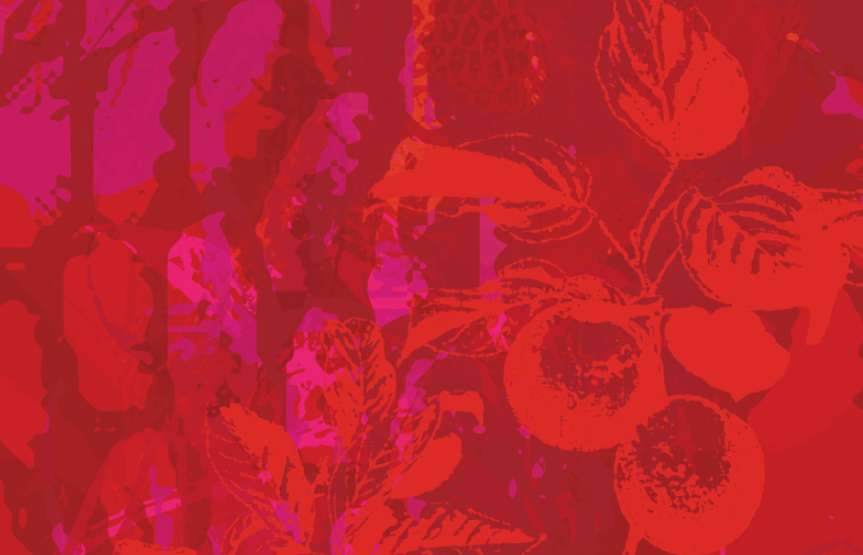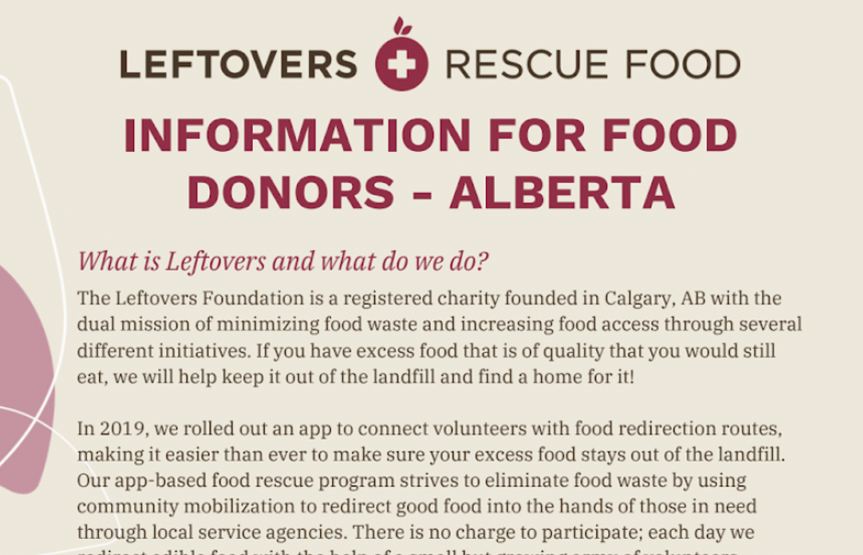Resource Center
- Resources
- FAQ's

2020 Annual Report


2019 Annual Report


2018 Annual Report


Manitoba Food Donor Information


Alberta Food Donor Information


Information for Service Agencies


Donated Food Guidelines


OFRE and Home Harvest Transition


How-To Guide Leftovers App


Leftovers - Tax Receipt Policy


Myth Busters

Volunteer FAQ's
Thank you for your interest in volunteering with the Leftovers Foundation! We post all of our volunteer opportunities on our Rescue Food App. Instructions for downloading and using the app can be found here.
You can watch a tutorial video on how to use the app here.
If you have additional questions about using the app, contact us.
In Calgary, the following agencies can accept donations around the clock:
- Calgary Community Fridge (902 Centre St N)
- Calgary Dream Centre (4510 Macleod Trail S)
- Alpha House (203 15 Ave SE; ready-to-eat donations only)
In Edmonton, the Edmonton Food Bank is open during the following hours:
- M-T, 8:30 a.m. to 8:00 p.m.*
- F-S-S: 8:30 a.m.- 4:30 p.m.
- CLOSED - all major holidays and long weekends
For donations that are not primarily bread products, Urban Manor Housing Society (9524 104 Ave NW) accepts donations around the clock as well.
In Winnipeg, the following agency can accept donations around the clock as well:
- Rossbrook House (658 Ross Ave)
Unfortunately, as of now, there are no agency partners in Airdrie or Hinton accepting donations outside of normal work hours. As a last resort, if an agency in your city is unavailable to accept donations, please compost the food and keep it out of our landfills. Let us know by contacting us, so that we can assure that it won’t happen again.
Please try the following:
- Make sure the app is up-to-date (check the App Store or Google Play for updates).
- Make sure that cellular data is turned on for the Rescue Food App by double checking in your phone’s settings.
- Try logging out and closing the app, and then sign in again.
- Delete and re-download the app.
We encourage volunteers to take photos while picking up donations. You can upload a photo on the app when you complete your route.
PLEASE NOTE: to respect the privacy and sensitivity of the service agencies, do not take photos at the dropoff points.
We have scales, food thermometers, tote bags, t-shirts, and reusable masks, free for volunteers, no matter how many routes you have completed. Supplies are optional and are not required to volunteer, provided you bring your own mask.
- Scales are used to measure the weight of donations — this data is important for us to track our impact! If you don’t have a supplied scale, a bathroom scale works as well. If you are able to guess the weight of objects well, then that is another option.
- Thermometers are only required for pickups with a cooler icon in the app. This icon indicates that you may be picking up refrigerated or frozen items. AHS requires that we record the temperature of these items to ensure that they are being transported safely (detailed instructions on this can be found in Appendix C of our Donated Food Guidelines).
Service Agency FAQ's
Fill out the agency questionnaire here on our website and one of our team members will be in touch with you!
This depends on what our food donors have to donate and varies from week to week. Some donors are more predictable (e.g., bakeries will donate bread and sometimes treats), while others are much more unpredictable (e.g., grocers may have an entire case of yogourt one week and an entire case of bananas the next).
All of our food donors and volunteers have read and agreed to abide by AHS’ Guidelines for the Distribution of Donated Foods as well as our Leftovers Donated Food Guidelines. Leftovers will redistribute food that is past its ‘best before date,’ but we won’t redistribute food that is past its ‘expiry date.’ For clarification on this, please read Appendix B in our Donated Food Guidelines.
Food Donor FAQ's
Fill out our donor agreement and one of our team members will be in touch to get you setup for donation pickups!
We use a general quality-standard: If you would eat it, we will rescue it. For a detailed description of foods that can and cannot be donated, check out AHS’ Guidelines for the Distribution of Donated Foods, as well as Leftovers Donated Food Guidelines.
There is a common misconception that a donor is liable if someone gets sick from the food they donated. The Charitable Donation of Food Act (Alberta) and the Food Donations Act (Manitoba) protects donors from liability associated with the donation of food. As such, there is no liability associated with donating food.
We can issue tax receipts for some food donations! Our tax receipt policy can be found here. Don’t hesitate to contact Leftovers if you have any questions.
Home Harvest FAQs
The goal of our Home Harvest program is to ensure that excess, home-grown produce from our communities is not wasted. If you have food growing in your yard that you would like to share, we will organize volunteers to pick it up and redirect it to local service agencies. From us, it can be distributed as is, or to our ANEW upcycling program – where it will be used in a beautiful culinary creation and sold in support of the Leftovers Foundation.
The Home Harvest program is available through the Rescue Food App. Routes are laid out in the same way, for your convenience. Be sure to upload your photographs through the app, for the rest of our community to see.
Fill out the Harvest Request Form here on our website and someone from our team will contact you with more info!
Yes! You can either harvest the food yourself and we will help redirect it, or we can arrange for our volunteers to harvest the food for you. Let us know your preference when filling out the Harvest Request Form.
Fresh Deliveries FAQs
Our hardworking volunteers pack and deliver boxes of food – containing a carton of eggs, fruit, vegetables, and a loaf of bread every Tuesday and Thursday. An order can be placed here for one or two orders – you can also order extra fruits and vegetables if you need them.
Our pay-what-you-want model means that you decide what you pay. We list a suggested price, but if you are unable to pay, you can enter $0 and your box will be donated for you.
You can call our team at (587) 779-5009 if you are in Calgary, or (780) 809-1962 if you are in Edmonton, and we’ll help you fill out your order form or answer any questions you have. We also have interpreter services available if you call (403) 616-4122.
Donations are graciously accepted. If you pay more than the suggested price for your order, it will enable us to provide more free orders for others who need it. If you want to support the program, you can donate to our Pay It Forward fundraiser.
Fresh Deliveries volunteer opportunities are also available through the Rescue Food App. Schedule pick-ups and drop-offs as a volunteer through the app and upload photographs to share with our community.
General FAQs
The Leftovers Foundation was founded by Lourdes Juan, a Calgary-based entrepreneur and philanthropist. Read more about Lourdes’ story here.
Over 49 billion dollars worth of food is wasted in Canada every year. This value is based on avoidable food waste – from production, processing and manufacturing, distribution, retail, consumer, and hotels, restaurants and institutions.
Most avoidable food waste occurs during the processing and manufacturing stage of the food supply chain – a value of over 20 billion dollars. However, the second largest value in avoidable food waste comes from the consumer stage – over 10 billion dollars.
- Shop smart and realistically
- Buy only what you need and keep track of what’s in your fridge before you go shopping – so you won’t double up on products you don’t need.
- Plan out your meals by writing a detailed shopping list.
- Purchasing locally sourced produce and food from local farmer’s markets also helps!
- Make the freezer your friend
- You can freeze just about anything to give it a longer life.
- Only take what you can eat
- At all-you-can-eat buffets, take only what you can eat.
- When making food at home, keep it in mind to make meals reasonably portioned – which will also help to prevent food waste.
- Keep track of what you throw away
- This will help you figure out which food items you’re wasting on a regular basis.
- Adding dollar signs to what you throw away will add value to what is being wasted.

